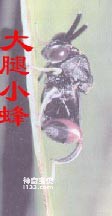Parasitic natural enemies are also a powerful force in protecting plants from enemy damage. Parasitoid wasps are the most common type of parasitic insects, belonging to the order Hymenoptera. They have two pairs of thin, transparent wings. Parasitic wasps are very capable and can find pests wherever they are hiding. Different from predatory insects, parasitic insects generally actively search for a host as adults, and when they find a host, they lay eggs in their bodies. After hatching, the larvae feed on the host's nutrients and live in symbiosis with the host for a period of time before killing the host. Larvae cannot actively search for food. There are many types of parasitic wasps, which parasitize the host at different stages of development. The common ones are small wasps, wasps, braconid wasps, and wasps. Taking the tea worm moth as an example, 22 species of parasitic wasps that parasitize this insect were collected in one tea garden alone. One species is parasitic in the egg stage, 10 species are parasitic in the larval stage, and 11 species are parasitic in the pupa stage. Here is a brief introduction to a pupal-stage parasitoid of the tea-tailed moth, the broad-legged wasp.

The leg segments of the hind legs of the Thighfoot Wasp are particularly thick, hence the name. Although the broad-legged wasp is small, it appears to be very strong. It has a wide range of hosts, with more than 100 known species, generally parasitizing the pupae of Lepidopteran and Diptera insects. In tea gardens, it mainly parasitizes the tea worm. The parasitism rate of this parasitic wasp can reach up to more than 50% in summer. During the peak period of emergence of parasitoid wasps, many broad-legged wasps can often be seen in tea gardens not high above the tree canopy, sometimes circling at low altitudes for aerial exploration, and sometimes landing on the leaves to search on foot. In order to avoid the attack of natural enemies, the tea moth weaves leaves into pupae and pupates in them. Even so, they cannot escape the superb reconnaissance skills of Guangtama Xiaofeng. Once it discovers an enemy, the wasp bites a small hole about 1 mm in diameter on the pupa with its mouth, inserts the end of its abdomen into the hole, and then stretches out its needle-shaped ovipositor to lay the eggs. inside the host pupa. Although the tea-tailed moth will swing its pupa body desperately to resist tenaciously, it is unable to save itself at this time.

The eggs of the broad-legged wasp produced by the tea worm moth hatch after 1-2 days. The larvae feed on the nutrients of the host pupa to grow and develop, and pupate in the host pupa. After about 3 weeks, the new broad-legged wasp will hatch. The adult wasp emerges and begins to fly freely. For a newly emerged female adult, her top priority is to reproduce her offspring to the maximum extent, that is, to parasitize as many hosts as possible. If there are enough pupae of the tea tree moth here and now, then their best strategy is to devote all their energy to reproduction as soon as possible and complete the task of laying eggs and parasitism in the shortest possible time. On the contrary, it uses most of its energy to maintain life and wait for the host to appear. Once an appropriate number of hosts appear, they quickly change their physiological state to a reproductive state.

animal tags: wasp
We created this article in conjunction with AI technology, then made sure it was fact-checked and edited by a Animals Top editor.